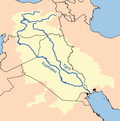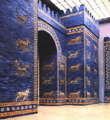Tigris
| Tigris | |
|---|---|
 Tigris river in Baghdad | |
 Map of the Tigris–Euphrates river system | |
| Location | |
| Country | Turkey, Syria, Iraq, Iran |
| Source region | Taurus Mountains |
| Cities | Elazığ, Diyarbakır, Mosul, Baghdad |
| Physical characteristics | |
| Source | Lake Hazar[1] |
| • location | Gölardı, Turkey |
| • coordinates | 38°29′0″N 39°25′0″E / 38.48333°N 39.41667°E |
| • elevation | 1,150 m (3,770 ft) |
| Mouth | Shatt al-Arab |
• location | Al-Qurnah, Iraq |
• coordinates | 31°0′18″N 47°26′31″E / 31.00500°N 47.44194°E |
• elevation | 1 m (3.3 ft) |
| Length | 1,900 km (1,200 mi) |
| Basin size | 375,000 km2 (145,000 sq mi) |
| Discharge | |
| • location | Baghdad |
| • average | 1,014 m3/s (35,800 cu ft/s) |
| • minimum | 337 m3/s (11,900 cu ft/s) |
| • maximum | 2,779 m3/s (98,100 cu ft/s) |
| Basin features | |
| Progression | |
| • right | Wadi Tharthar |
| [2][3] | |

The Tigris (/ˈtaɪɡrɪs/ TY-griss; see below) is the eastern of the two great rivers that define Mesopotamia, the other being the Euphrates. The river flows south from the mountains of the Taurus in Turkey, then through the Syrian and Arabian Deserts, emptying into the Persian Gulf.
Etymology

The
Another name for the Tigris used in


The name of the Tigris in languages that have been important in the region:
| Language | Name for Tigris |
|---|---|
| Akkadian | 𒁇𒄘𒃼, Idiqlat |
| Arabic | دِجلَة, Dijlah; حُدَاقِل, Ḥudāqil |
| Aramaic | דיגלת, Diglath |
| Armenian | Տիգրիս, Tigris, Դգլաթ, Dglatʿ |
| Greek | ἡ Τίγρης, -ητος, hē Tígrēs, -ētos;
ἡ, ὁ Τίγρις, -ιδος, hē, ho Tígris, -idos |
| Hebrew | חידקל, Ḥîddéqel, biblical חִדֶּקֶל, Ḥiddeqel[5] |
| Hurrian | Aranzah[6] |
| Persian | : دجله Dejle |
| Sumerian | 𒁇𒄘𒃼 Idigna/Idigina |
| Syriac | ܕܸܩܠܵܬܼ Deqlaṯ |
| Turkish | Dicle |
Kurdish
|
Dîcle, Dijlê, دیجلە |

Geography
The Tigris is 1,750 km (1,090 mi) long, rising in the
Close to its confluence with the Euphrates, the Tigris splits into several channels. First, the artificial
The Tigris has long been an important transport route in a largely desert country. Shallow-draft vessels can go as far as Baghdad, but rafts have historically been needed for transport downstream from Mosul.[9][10][11]
Management and water quality

The Tigris is heavily dammed in Iraq and Turkey to provide water for irrigating the arid and semi-desert regions bordering the river valley. Damming has also been important for averting floods in Iraq, to which the Tigris has historically been notoriously prone following April melting of snow in the Turkish mountains. Mosul Dam is the largest dam in Iraq.
Recent Turkish damming of the river has been the subject of some controversy, for both its environmental effects within Turkey and its potential to reduce the flow of water downstream.
Water from both rivers is used as a means of pressure during conflicts.[12]
In 2014 a major breakthrough in developing consensus between multiple stakeholder representatives of Iraq and Turkey on a Plan of Action for promoting exchange and calibration of data and standards pertaining to Tigris river flows was achieved. The consensus, known as the "Geneva Consensus On Tigris River", was reached at a meeting organized in Geneva by the think tank Strategic Foresight Group.[13]
In February 2016, the
Religion and mythology
In Sumerian mythology, the Tigris was created by the god Enki, who filled the river with flowing water.[16]
In
The Tigris appears twice in the Old Testament. First, in the Book of Genesis, it is the third of the four rivers branching off the river issuing out of the Garden of Eden.[5] The second mention is in the Book of Daniel, wherein Daniel states he received one of his visions "when I was by that great river the Tigris".[17]
The Tigris River is also mentioned in Islam in Sahih Al-Bukhari and Muslim which described the river (Euphrates) will dry up near the end time to unveil a treasure of gold and has prohibited anybody to take the gold

The river featured on the
See also
- Assyria
- Cradle of civilization
- Ilisu Dam Campaigncampaign against a dam on Tigris in Turkey
- List of places in Iraq
- Mountains of Ararat
- Geography of Iraq
- Zagros Mountains
References
- ^ Nicoll, Kathleen. "Geomorphic Evolution of the Upper Basin of the Tigris River, Turkey". University of Utah. Archived from the original on 2023-10-25. Retrieved 2021-09-05.
- ^ S2CID 129706440.
- ISBN 0-8093-1572-6.
- ^ F. Delitzsch, Sumerisches Glossar, Leipzig (1914), IV, 6, 21.
- ^ a b Genesis 2:14
- ^ E. Laroche, Glossaire de la langue Hourrite, Paris (1980), p. 55.
- ^ "Diyarbakir". europeanwalledtowns. Archived from the original on 2023-10-25. Retrieved 2019-11-10.
- ^ Pliny: Natural History, VI, XXVI, 128-131
- ^ Namio Egami, "The Report of The Japan Mission For The Survey of Under-Water Antiquities At Qurnah: The First Season," (1971-72), 1-45, https://www.jstage.jst.go.jp/article/orient1960/8/0/8_0_1/_pdf Archived 2018-10-31 at the Wayback Machine.
- ^ Larsen, M.T., The Conquest of Assyria: Excavations in an Antique Land Archived 2023-03-26 at the Wayback Machine, Routledge, 2014, pp 344-49
- ^ "Mesopotamia, Tigris-Euphrates, 1914-1917, despatches, killed and died, medals". naval-history.net. Archived from the original on 19 November 2015. Retrieved 28 November 2015.
- ^ Vidal, John. "Water supply key to the outcome of conflicts in Iraq and Syria, experts warn Archived 2016-12-04 at the Wayback Machine" The Guardian, 2 July 2014.
- ^ "Analysis & Water Agenda". ORSAM. Archived from the original on 2015-09-24. Retrieved 2015-11-28.
- ^ Borger, Julian (29 February 2016). "Iraqi PM and US issue warnings over threat of Mosul dam collapse". The Guardian. The Guardian. Archived from the original on 29 February 2016. Retrieved 29 February 2016.
- ^ "US warns of Mosul dam collapse in northern Iraq". BBC News. BBC. BBC. 29 February 2016. Archived from the original on 29 February 2016. Retrieved 29 February 2016.
- ISBN 0-19-926311-6, p. 220–221.
- ^ Daniel 10:4
- ^ "Riyad as-Salihin 1822 - The Book of Miscellaneous ahadith of Significant Values - كتاب المنثورات والملح - Sunnah.com - Sayings and Teachings of Prophet Muhammad (صلى الله عليه و سلم)". sunnah.com. Archived from the original on 2023-03-02. Retrieved 2023-03-02.
- ^ "Sunan Abi Dawud 4306 – Battles (Kitab Al-Malahim) – كتاب الملاحم – Sunnah.com – River of Dajal(Tigris)". sunnah.com. Archived from the original on 2021-04-13. Retrieved 2021-02-10.
External links
- Livius.org: Tigris
- Hausleiter, A.; M. Roaf; St J. Simpson; R. Wenke; P. Flensted Jensen; R. Talbert; T. Elliott; S. Gillies (27 December 2020). "Places: 912964 (Tigris/Diglitus fl.)". Pleiades. Retrieved March 9, 2012.
- Managing the Tigris and Euphrates Watershed
- Bibliography on Water Resources and International Law Peace Palace Library
- Outline of WWI Battles involving the Tigris River
- Old maps of the Tigris, Eran Laor Cartographic Collection, The National Library of Israel


